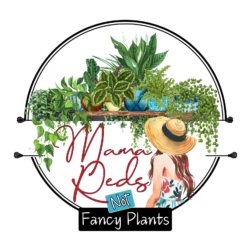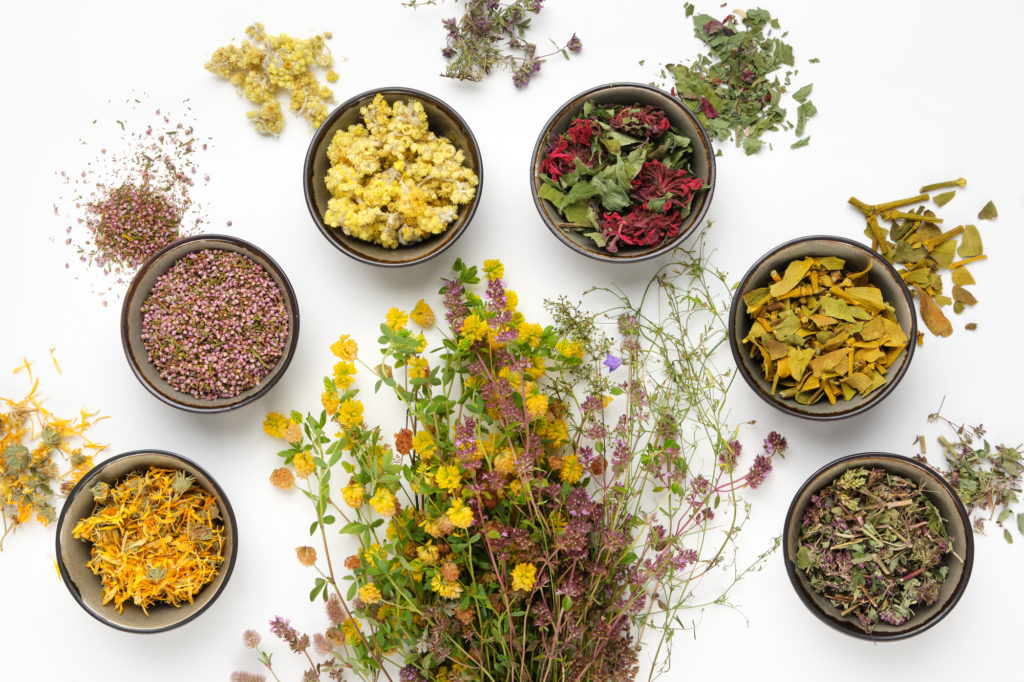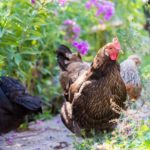Herbs are plants that are traditionally used to enhance the flavor of foods as well as offer loads of health benefits. During spring and summer, they are found in most stores and farmers markets. If you are passionate about cooking and have been wanting to start a garden, then growing herbs is a great start. With the right amount of sun, water and organic soil, they are easy to grow.
Here are eight reasons you should be growing your own herb garden this year:
- They’re Fresh – Buying herbs from the store may seem easy, but fresh herbs can quickly go bad. Having your own herb garden means you can have any herb you want on hand and fresh, without the need to substitute for dry ones.
- Save Money – Herbs at grocery stores or even farmers markets can be quite pricey, especially if you are trying to make some delicious sauces or pesto that need larger quantities. You can simply save money by pulling the herbs from your garden without the stress of running out, because more will continue to grow from your initial investment of seeds or starter plants.
- So Healthy – Fresh herbs offer many health benefits. Most are anti-inflammatory, high in antioxidants and help aid in digestion. You can get all these benefits from your own herb garden without added pesticides.
- Beautiful and Smell Fabulous – Herbs are highly aromatic and pleasing to the eye. They make great additions if you want to add a few pops of color, like violet from lavender. Feverfew is another choice that looks like small daisies with a bright yellow center and white petals.
- Fun and Easy – Most herbs are quite easy to grow, which makes them less stressful and more fun compared to other plants in the garden. You can grow herbs outdoors or even inside on windowsills or other areas of the house that have adequate sunlight.
- More Variety – A home herb garden offers what most stores can’t and that is variety. There are hundreds of herbs to choose from and the choice is yours.
- They Provide Some Pest Control – If you are having trouble keeping insects or other pests out of your garden, then plant herbs such as basil, lavender or rosemary. These herbs are known to repel pests due to their strong scents.
- Taste Is Exceptional – Fresh herbs offer the best flavor. That is because when picked, herbs release an oil that is responsible for their flavor. This oil breaks down fast, which is why herbs are best fresh and have such a rich flavor when first picked.
As you can see, there are plenty of reasons why you should be growing your own herb garden. Your taste buds and wallet will thank you over time, and you will no longer need to make multiple trips to keep fresh herbs around the house.
Proper Care for Herbs
Herbs are easy to grow and quite rewarding. As long as they have proper sunlight and water there will be plenty to use for recipes. You might even need to give your neighbor some as well. However, there are a few things that continually need to be done to keep your garden growing.
The following are a few basic tips when caring for and maintaining your herb garden.
Watering
Herb gardens need to be watered regularly. Each herb has different requirements but most enjoy a soil that is moist. If you have started an herb garden from containers, more than likely they will need to be watered daily as they tend to dry out faster. Keep an eye on the weather as that will also play a factor in how much watering needs to be done.
Weeding
As with any gardens, you need to keep up with the weeds. Weeds can destroy a garden by causing diseases and not allowing enough space for your herbs to grow. Weeds will also take over the water supply and cause the herbs to wilt. If there are any signs of weeds, pull them immediately.
Pruning
Believe it or not, these delicate plants need to be pruned. Well-pruned herbs will continue to grow year-round and prevent them from going to seed. Pruning keeps the garden well maintained and allows you to spot any pests or diseases trying to infiltrate your garden.
Harvesting and Relocating
When the weather starts to cool down, most herbs will need to be moved indoors. Some herbs such as mint, thyme, oregano, sage, and chives can survive the cooler months. To harvest these herbs, cut the leaves and stems, leaving about two inches of growth from the soil.
Feeding
Herbs generally do not need much attention when it comes to feeding them, but it is a good idea to test your soil first and follow the appropriate guidelines to have a healthy supply of herbs. Compost or organic fertilizers are best. For herbs grown in containers, use slow-release and water-soluble fertilizer.
Mulching
Add two to four inches of mulch around herbs to prevent the growth of weeds. When adding mulch to your garden, make sure to avoid the crown of the herb plant. Proper mulching will also regulate the soil temperature and help conserve moisture. Use organic materials such as grass clippings, shredded leaves or old compost.
Continue to follow these tips as you grow your herb garden, and you are sure to have a bountiful supply of herbs. Herbs are a great addition to foods and provide great health benefits, as most of them are anti-inflammatory and high in antioxidants.
What to Avoid When Growing Herbs
Starting an herb garden is a great way to add flavor to your foods or decoration to your garden or home. If you are looking to set up a garden and never have before, then an herb garden is a great place to start because it’s fairly simple. Before you get started, though, here are a few common mistakes people make when starting an herb garden that you should avoid.
* Starting from Seed – Starting herbs from seeds can come with some unknown complications. There are plenty of starter plants that can be found at gardening stores that will bring better luck and less stress to your herb garden, especially if you are new to herb gardening.
* Picking Unhealthy Plants – When looking for starter plants, find ones that are bright in color, have plenty of foliage and no signs of bugs or eggs.
* Too Much Variety – Starting an herb garden can be quite exciting with all the options available, but it is best to start small. This way you are not too overwhelmed and can learn what each variety of herb likes as they grow. For example, some herbs like cilantro are sensitive to drought and can die easily if not watered properly.
* Incorrect Planting – When you are first starting an herb garden, it is best to keep the different types separate and not overcrowd. Be sure to do your research on what herbs to grow well together as well. Herbs like mint will take over pretty much any space you put them in.
* Not Enough Water – It is easy to confuse herbs with houseplants when it comes to watering. They are small and seem delicate, so less water seems right, but most herbs actually prefer daily watering. Make sure the water mostly touches the soil and not the leaves.
* Using Bad Soil – Most soil on the ground lacks the proper nutrients to allow an herb garden to flourish. Use organic soil or potting soil with organic compost for best results.
* Not Pruning Soon Enough – Pruning your herbs is an important step because it encourages even and fast growth. Skipping this step prevents the herb from regrowing and producing more herbs. Cut the herb down to just about a set of growing leaves and always cut from the top, not the bottom.
* Wrong Environment – Not enough sun, too much sun, too cold outside or too hot outside… these factors all play a role in how well your herbs grow. Most herbs need about six hours of proper sunlight but prefer an environment at around 65 to 75 degrees F.
If you keep these common mistakes in mind when starting your own herb garden, you will have a fun and great time gardening. And if you do make mistakes, it’s OK – just keep learning and keep growing.
Creating Your Own Herb Containers
Growing herbs is not only easy but also fun, because they are versatile and can be planted pretty much anywhere and in anything. As long as they have plenty of sunlight, good soil, and water, they will flourish.
Here are a few DIY container ideas to grow your herbs in.
* Mason Jars – Mason jars are a cute and decorative way to grow herbs. Simply take a few jars and put a small layer of pebbles at the bottom of each one. This way the water can drain from the soil. Mason jars can fit nicely on a window sill or even be added to a slab of wood with a few metal rings and screws.
* Plastic Bottles – Using plastic bottles is a great way to reduce pollution and reuse those old water, soda, and milk bottles. There are plenty of ways you can alter plastic bottles for growing herbs. A quick and easy method is to cut off the top where the cap is and poke a few holes on the bottom of the bottle, big enough for water to drain out a little. Fill the bottle up with some organic soil and you are ready to go.
* Shoe Organizer – As crazy as a shoe organizer sounds, this is a great option for limited space. It can easily be hung on a wall or fence. Choose a shoe organizer that has fabric which allows water to drain easily, then fill each pouch with organic soil with about an inch of space left on the top. Now all you need are your herbs.
* Tin/Food Cans – Tin cans are another great option for those wanting to reduce pollution, and will save you money without having to purchase potting plants. After you use your food can, rinse it out thoroughly and remove the label and any sticky residue left behind. Decorate the can however you like and add a layer of pebbles to allow water to drain. Add herbs and organic soil and you are done.
* Old Boots – An old boot is a great way to add some unique decorations to your garden. First, you will need to drill some holes on the bottom of the boot to allow water to drain. Then add some potting soil and your herb of choice.
* Teacup – Using a teacup is a simple and cute way to decorate your kitchen and make it useful at the same time. Drill a few holes in the bottom of the teacup. Then add a layer of pebbles, some organic soil and your choice of herbs.
* Baskets – Baskets can be used to grow herbs by simply filling them up with soil and hanging them around the garden. They also save space.
The list of “do it yourself” containers for growing herbs in is practically endless. Just about anything around your house can be used. Look at Pinterest for more ideas to get your creative juices flowing.
Outdoor Herb Garden
For some cooks, having an outdoor herb garden is the ultimate in luxury. Not only will everything be beautiful, but it’ll taste delicious too. Good cooking relies on good ingredients that inspire you to cook at a whole new level. An outdoor herb garden can make all the difference. What’s more, it’s not hard to do.
* Location – The location of your herb garden is very important. You want it to be close to your kitchen, so you can easily go out and get some for dinner. Consider using pots so that you can easily move them inside if needed for inclement weather. If you do that, you can grow herbs right on a trolley in pots and move it around where you want it.
* Prepare the Soil – You can simply buy a premixed soil for herbs and edible gardens. You can get that soil from any garden store including Lowe’s, Home Depot, and Walmart. It’s easy to find and easy to use. You can also mix your own if you compost. However, you’ll need to know what each plant needs to ensure that you get it right.
* Choose Your Herbs – Determine which herbs you want to plant. If you use the pot method instead of putting them directly into the ground, you can plant anything you want. Otherwise, you need to learn which herbs should be planted together and which shouldn’t. Planting herbs as companion plants with the rest of your garden can work wonders too.
* Start from Seeds or Plants – If you’re starting from seeds, you’ll probably need to get them started inside to baby them a little. If you’re starting with plants, just plant them in the spot you’ve set up for that plant.
* Water – Of course you need water. Make sure you have good water. If your water has a lot of minerals in it or smells a lot like bleach, you may have issues. You may need another way to water your plants such as rainwater catchment or water that is filtered without added minerals.
* Prune/Trim/Pinch – Each type of herb is a little different regarding its care. Research your herb so that you know how to prune it properly as it’s growing to get the most from it. Also, learn how to properly harvest herbs from your plants so that you can keep them growing for a long time.
Finally, enjoy your efforts with your first harvest. Start looking up recipes that use more herbs so that you can get the most enjoyment out of your outdoor herb garden. You can even dry them or freeze them so that you can easily use them all year long. To freeze, add to an ice tray, then add water. To add to soups and stews, just add an ice cube. To dry, hang upside down in an airy place and store in a cool, dry place.
Indoor Herb Garden
Growing an herb garden indoors can be rewarding and fun. And it can be simple if done the right way from the start. Proper education before you get going is the key to success.
Here are eight tips to keep in mind when growing an herb garden indoors.
- Adequate Sun Exposure – Most herbs need sun for about six to eight hours a day, so make sure you find a location in your house that offers this amount of sunlight. Proper sunlight is also responsible for the flavor of your herbs. The more sunlight they get, the better the flavor.
- Proper Temperature – Keep the temperatures in your house or the room the herbs are located in at around 65 to 75 degrees Fahrenheit. If you need to reduce the growth of herbs, reduce the temperatures to about 60 degrees Fahrenheit.
- Water – Herbs need a moderate amount of water daily. It is best to keep the soil of herbs damp. Watering can easily be forgotten, so make a plan and keep to a schedule. Remember, now that the herbs are indoors they do not get water from rain, so it is up to you to keep up with it.
- Keep Herbs Separate – For long-term success, you should keep your herbs separate. This way they can each get the individual attention they need. It also helps with plant rotation, and if one plant gets infested with pests the others don’t have to suffer.
- Proper Containers – Containers need to have proper drainage so that the herbs are not sitting in too much water. Add a thin layer of rocks to the bottom of your pots before filling with soil to allow the water to settle there instead of in the soil. You may even need to poke or drill a few holes in the bottom of the container if they don’t have any to start with.
- Rotate – Herbs need proper rotation under the sun to help with air circulation and to prevent mold. Turn your plants or rotate them a little every day so that each side gets the right amount of sun. This will also promote even growth.
- Soilless Potting Mix – Indoor herbs need special attention when it comes to soil because it needs to provide more drainage. Dirt from the ground is too compact and usually less nutritious. Make sure you pick a soil that is listed for indoor gardens.
- Feed with Fertilizer – Fertilize your herbs once a week to promote strong growth. The best fertilizers for herbs are seaweed extract or fish based.
Keep these tips in mind when starting or growing your indoor garden. This way you are sure to have a garden that will keep up with your delicious recipes. You’ll wow your family and your guests.
Kitchen Herb Garden
Fresh herbs are a wonderful addition to meals, providing great flavor and health benefits. The amazing thing is that there are plenty of herbs you can grow in your house without the need for a home garden. All you need is a few windowsills with proper sunlight, water, and a few plant pots.
- Basil – Basil is an amazingly versatile herb that can be used for just about anything, from pesto to sauces or even frozen desserts like watermelon sorbet. Basil offers a nice peppery mint flavor and is said to be a powerful antibacterial.
- Chamomile – Chamomile is an herb traditionally used as medicine due to its anti-inflammatory and calming properties. Chamomile is best in teas to help ease an upset stomach or help you sleep.
- Chives – Chives have a mild onion flavor that goes great with soups and vegetable dishes. Add chives to butter or cream cheese to make a savory spread.
- Lavender – Lavender is a beautiful herb that can be used in foods or even for cosmetic uses like homemade face masks. Lavender can help ease anxiety and depression and has anti-inflammatory properties.
- Mint – Growing mint indoors is actually a better option overall because mint tends to run wild and take up the whole garden. Keeping mint by itself, in a small container, will control the growth. Use mint to enhance the flavor of water or even throw it into a delicious smoothie.
- Oregano – Oregano is a bright green leafy herb that is traditionally used in Greek or Italian dishes. Oregano has a strong but appealing flavor, so a little goes a long way.
- Parsley – This bright green leafy herb has a peppery flavor that is traditionally used as a garnish but can also make a great flavor enhancer to many protein dishes. Parsley is also an anti-inflammatory and high in vitamin C, calcium, iron and fiber.
- Rosemary – Rosemary is a highly aromatic herb that has wood-like stems and short pine-like needles. This herb can be used by itself as an air freshener or used to enhance the flavor of meats like lamb, pork, and chicken.
- Sage – Sage is an aromatic herb that has a bitter taste that pairs best with dairy. This herb is high in antioxidants and helps improve digestion.
- Thyme – This herb is used in the Mediterranean, Italian and French dishes that we all love. It’s also often paired with other herbs such as rosemary, parsley, and oregano. Thyme has a sweet, pungent flavor and has small leaves with a woody stem.
The best part about having an herb garden in your kitchen is that they are readily available. Readily available herbs also have the best flavor and health benefits. Plus, they unleash creative cooking ideas.
Best Spring Herbs
If you are looking for an affordable, easy and great way to enhance the flavor of your foods, then start an herb garden. Herbs take little effort and do not need much space. In fact, it’s best to plant herbs in containers to keep the soil well drained. This way you can bring them inside during the cooler months too.
* Basil – Basil has a warm and spicy flavor that pairs perfectly with soups and sauces. The best way to use up basil is to make pesto. Basil can be seeded directly into the garden during late spring and needs lots of sunlight.
* Chervil – Chervil is an herb that has a similar flavor to anise seeds. It’s an uncommon herb that won’t traditionally be found in grocery stores, but it adds great flavor to your morning eggs. Plant chervil when there are no signs of frost to come, because it’s sensitive to cold temperatures.
* Cilantro – Cilantro is a great herb to add a fresh flavor to guacamole and salsas. Cilantro aids digestion and is high in potassium. Make sure to keep your cilantro and parsley separate to not confuse the two. Pick a spot in the garden that offers the most sunlight and well-drained soil. Cilantro is sensitive to drought, so make sure to keep the soil moist.
* Epazote – If you enjoy cooking Mexican food then you need epazote in your garden, because it is unlikely you will find it in a grocery store. It has a peppery and minty flavor that is often found in beans and stews at Mexican restaurants. Once the danger of frost has passed, plant epazote in well-drained soil with access to full sun.
* Dill – Dill is widely used in Europe to enhance the flavor of fish, potatoes, and dairy. It is most commonly known for pickling. It has an earthy flavor and aroma similar to fennel. You will want to sow dill seeds directly into your garden because they do not grow well when transplanted.
* Lemon Balm – Lemon balm is an herb from the mint family that has a mild lemon aroma. Lemon balm is commonly used for its medicinal benefits as it helps upset stomach and bloating. Lemon balm can be seeded indoors during the colds months and then transplanted outdoors in late spring.
* Mint – Use this herb to add a nice kick to your tea or water. Mint even pairs well with lamb. Mint, like most herbs, should be grown in a pot to allow the soil to drain. Not only that, it tends to take over any space that is available, so growing it in a pot helps keep it manageable.
* Parsley – Parsley is mostly used as a garnish, but provides a lot of nutritional value and can be added to pretty much any dish. Parsley can grow in full sunlight or partial shade and needs moist, nutrient-rich soil.
To have the best results this year, keep each herb separate and make sure they have plenty of sunlight and water. A great idea for herbs is to use individual terracotta pots for planting so that you can plant whatever you want and move them around as needed.
What Herbs Can Be Planted Together?
Herbs are used for cooking, cleaning, and even for health reasons. For centuries, plants were the only medicine we had. People tended to their plants very carefully. Planting herbs for cooking is a great way to not only boost your kitchen creativity but also to get healthy.
Thankfully, many herbs grow just fine together. Plus, growing herbs is not hard to do. You can do it inside and outside with the right light, the right soil, and the right care. Let’s look at a few different ideas that you can start with.
Mediterranean Herbs
Mediterranean herbs such as rosemary, oregano, sage, thyme, marjoram, and lavender can be planted together due to their similar soil and climate needs. Mediterranean herbs flourish in dry and sandy soil similar to the soil and weather conditions in the Mediterranean Basin. This means these herbs will grow better in sunny, hot, and dry weather conditions.
Water-Loving Herbs
Basil, cilantro, tarragon, and parsley can be planted together because they prefer more moisture in their soil compared to Mediterranean herbs. When you plant things together that want the same type of soil, it makes your job a lot easier. Plus, you won’t have to worry about overwatering them.
Different Types of Mint Herbs
Any herb in the mint family should be planted together with other mints or by themselves. The mint family includes peppermint, spearmint, catmint, orange mint, and lemon balm. Herbs of the mint family should be planted alone because they tend to overgrow, disrupting other plants by taking their space and depleting their water sources. Mint herbs will also cross-pollinate, so be careful when pairing together or it can create some interesting flavors.
Make Them Companion Plants
If you have a salad garden or other type of garden, consider planting herbs as companion plants for your regular garden. For example, plant basil with tomatoes. Plant mint with cabbage or tomatoes. You can find the right companion plant for your garden inhabitants by looking it up on Google.
Use Pots
By far the simplest way to grow herbs is by using terracotta pots. Put plants together that can go together, and by putting them in pots you can move them around more easily and even bring them indoors to harvest without ruining your back. What’s great about using pots too is that you can turn these herbs into a beautiful extra whimsical touch in your garden.
When you plant the right herbs together based on their needs, you’ll end up with a healthier harvest and better-tasting herbs. And when you use herbs as companions to other types of vegetables and fruit that you’ve planted, you can help create permaculture that is pest resistant – which means you’ll use fewer pesticides and have better tasting herbs.
Necessary Supplies for Herb Growing
When you decide to start growing herbs, the next thing you need to do is figure out what supplies you need to buy. You may be able to find some things at home that you can use, at second-hand stores, as well as at the garden store. Plus, of course, you can find supplies to buy online via Amazon.
* Seeds – If you want to grow herbs from seeds, they can be purchased from many stores like the grocery store, Home Depot, Lowe’s, and more traditional neighborhood garden stores. But you can also order them online via Amazon kits, like this 5 Herbs from Organic Seeds kit. The important thing is to buy seeds from someone you trust.
* Space – You’re going to need some space to grow herbs. If you’re doing it indoors, you’ll need shelving that allows you to either move the plants to a window for direct light or that offers space for grow lights to be added. If you want to do it outdoors, you can even use a little portable outdoor greenhouse for your herb garden.
* Pots – The best pots to grow herbs in are pots that allow for easy irrigation. Terracotta pots are a good choice because they soak in water and help keep your seeds from drying out. But you do need to be careful not to overwater anyway.
* Potting Soil – Go to any garden supply store or even Walmart’s Garden Center to find the right soil. The soil mix really depends on exactly what you’re planting, but most of the time a premixed potting soil is enough for your herb garden.
* Plant Fertilizer – While you don’t really need that much fertilizer for herbs, feeding them on occasion is a good idea. It’ll make for a super-healthy plant, but you don’t need to overdo it. The type of fertilizer you use will depend on the herbs you are growing, as well as where you’re growing them. Try to use organic fertilizers for the best results.
* Water – Naturally you’ll need water. But one thing a lot of people don’t realize is that sometimes tap water isn’t the best choice. If your water is treated a lot or has a high level of limestone in it, you may need to ensure you have filtered water to use.
* Sunlight – Some herbs (such as basil) need full sun to grow, but others don’t. You’ll need to learn everything you can about the particular herb that you’re planting to find out how to properly care for it. If you don’t have sunlight, you can also use grow lights to help simulate the same thing that the sun does for the plants.
* Darkness – Some people don’t realize, but your herb plants also need darkness to fulfill the entire plant day cycle and grow properly. Ensure that no floodlights are directed to your garden area if it’s outside, and that you turn off lights in the house at night.
After that, the most that you need to grow herbs are your hands and a will to learn how to do it. It may take some practice to get it right, but growing your own herbs at home is a wonderful way to brighten up your cooking for not a lot of money.





